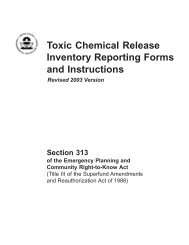(Lockout/Tagout) (revised 2002) OSHA 3120 - Seton
(Lockout/Tagout) (revised 2002) OSHA 3120 - Seton
(Lockout/Tagout) (revised 2002) OSHA 3120 - Seton
Create successful ePaper yourself
Turn your PDF publications into a flip-book with our unique Google optimized e-Paper software.
Before removing lockout or tagout devices, the employees<br />
must take the following steps in accordance with the specific<br />
provisions of the employer’s energy-control procedure:<br />
• Inspect machines or their components to assure that they<br />
are operationally intact and that nonessential items are<br />
removed from the area; and<br />
• Check to assure that everyone is positioned safely and<br />
away from machines.<br />
After removing the lockout or tagout devices but before<br />
reenergizing the machine, the employer must assure that all<br />
employees who operate or work with the machine, as well as<br />
those in the area where service or maintenance is performed,<br />
know that the devices have been removed and that the machine<br />
is capable of being reenergized. (See Sections 6(e) and (f) of<br />
29 CFR Part 1910.147 for specific requirements.) In the rare<br />
situation in which the employee who placed the lockout/tagout<br />
device is unable to remove that device, another person may<br />
remove it under the direction of the employer, provided that the<br />
employer strictly adheres to the specific procedures outlined in<br />
the standard. (See 29 CFR 1910.147(e)(3).)<br />
When do I use lockout and how do I do it?<br />
You must use a lockout program (or tagout program that<br />
provides a level of protection equal to that achieved through<br />
lockout) whenever your employees engage in service or<br />
maintenance operations on machines that are capable of being<br />
locked out and that expose them to hazardous energy from<br />
unexpected energization, startup, or release of stored energy.<br />
The primary way to prevent the release of hazardous<br />
energy during service and maintenance activities is by using<br />
energy-isolating devices such as manually operated circuit<br />
breakers, disconnect switches, and line valves and safety<br />
blocks. <strong>Lockout</strong> requires use of a lock or other lockout device<br />
to hold the energy-isolating device in a safe position to prevent<br />
machinery from becoming reenergized. <strong>Lockout</strong> also requires<br />
What must workers do before they remove their lockout or tagout device?<br />
9
















